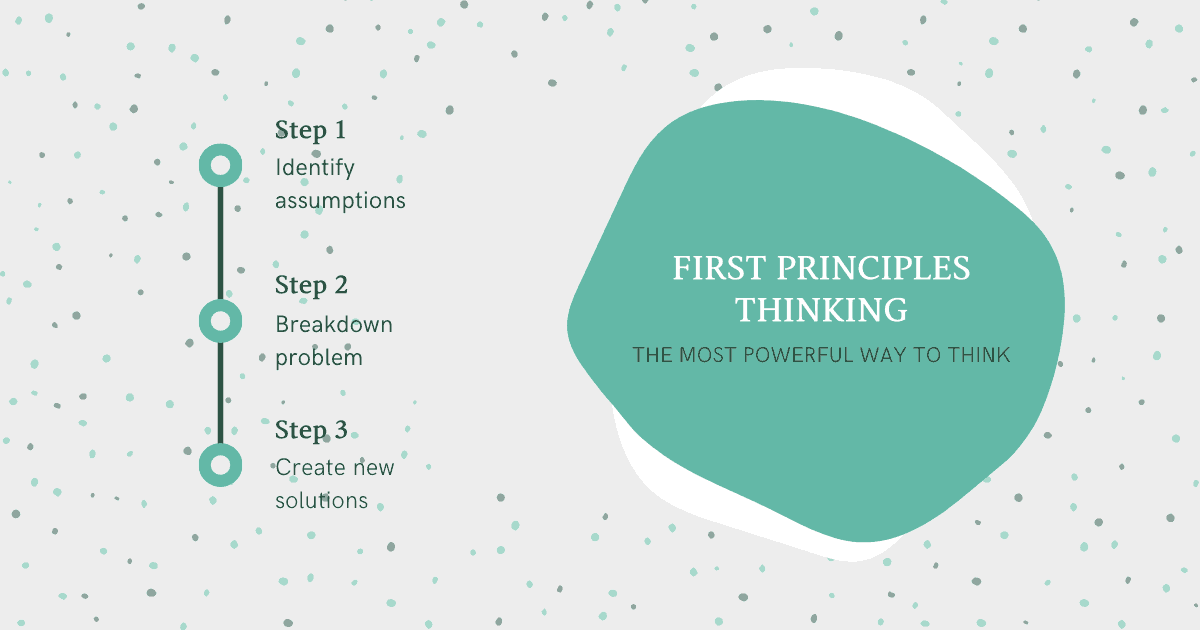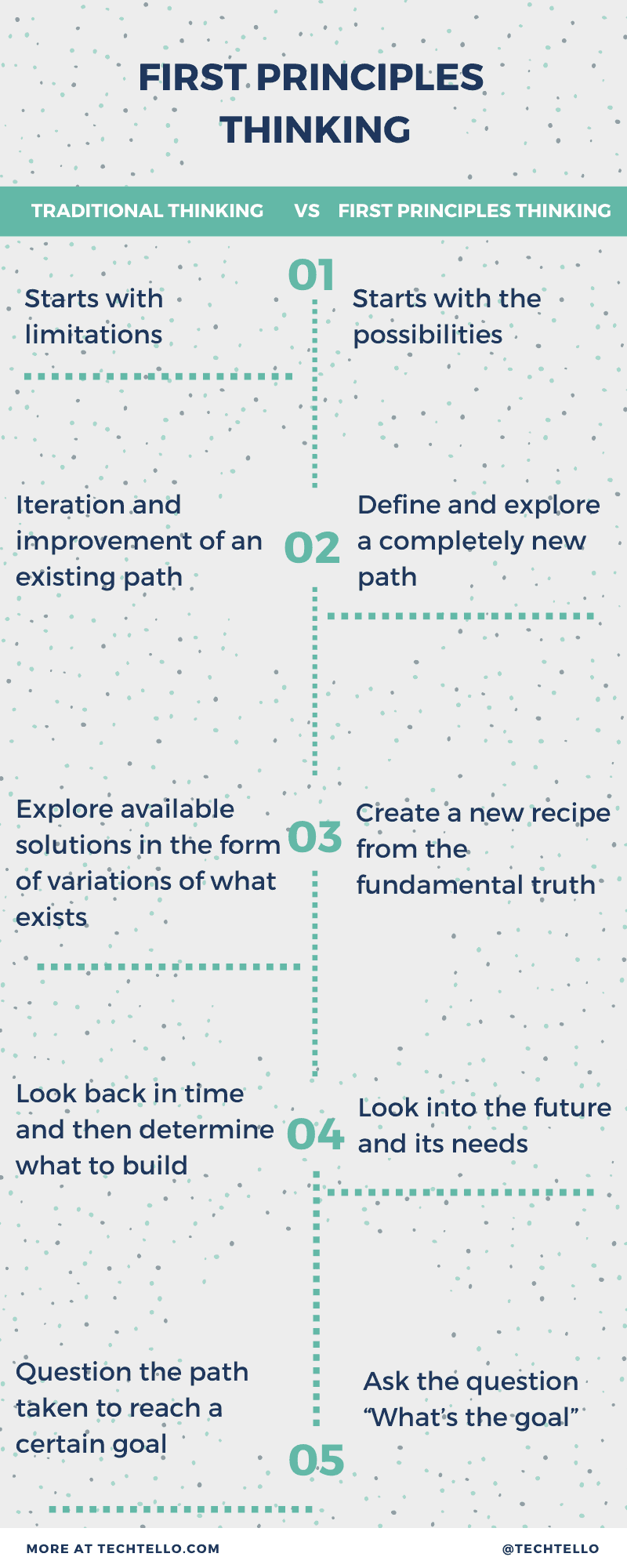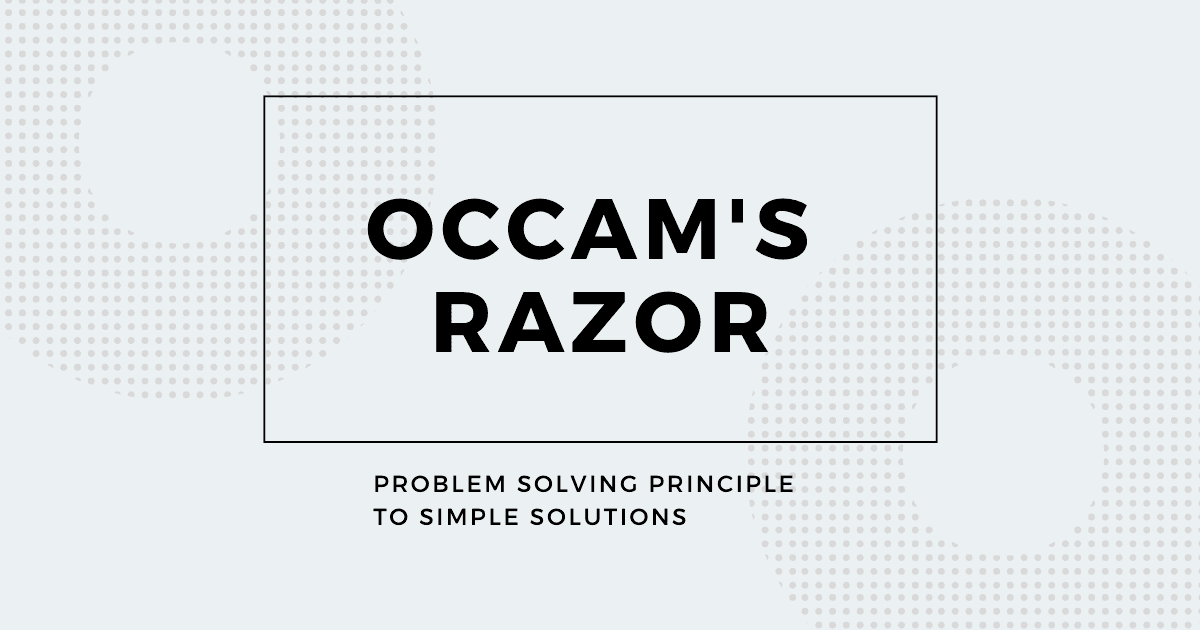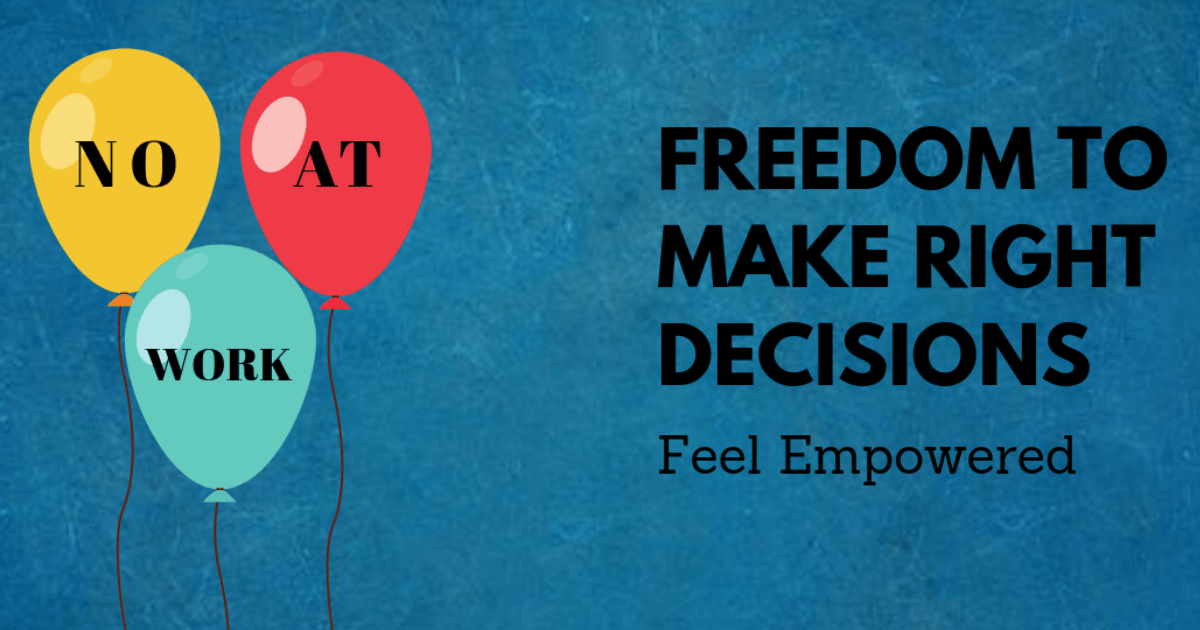First Principles Thinking: The Most Powerful Way To Think

First principles thinking drives complex problem solving and workplace innovation through reverse engineering. Companies that employ first principles thinking are one step ahead as they plan and build for the future.
We start with multiple principles in life governed by our values, perceptions, belief system and how we learn to reason. These principles lead to opinions and gives leeway to our brain to apply shortcuts in the form of conclusions it learnt before.
We learn to live with them without validating the underlying assumptions. The principles may be sound when we first started, but questioning if they still apply requires debunking old theories and creating new versions of reality for ourselves.
First principles thinking requires embracing a new mindset that identifies when our old way of doing things is obsolete. A shift in thinking that discards conventional wisdom, cuts through the dogma and questions our own beliefs.
Traditional thinking: How do we typically think?
- Starts with limitations
- Iteration and improvement of an existing path
- Explore available solutions in the form of variations of what exists without true knowledge
- Look back in time and then determine what to build
- Question the path taken to reach a certain goal
First principles thinking: How we should think?
- Starts with the possibilities
- Define and explore a completely new path
- Create a new recipe from the fundamental truth
- Look into the future and its needs
- Ask the question “What’s the goal”
First principles thinking (also called reasoning from first principles) requires breaking down a problem into its fundamental building blocks, its essential elements, asking powerful questions, getting down to the basic truth, separating facts from assumptions and then constructing a view from the grounds up.
It requires understanding that our experience may be different from reality and true knowledge can be attained by learning to integrate different ideas together. It fills the gap between the incremental mindset to opening ourselves to the beautiful world of possibilities.
Mind Map Templates
Work through complex problems, identify correlations, and see the big picture using these mind map worksheets.
Shutting down first principles thinking
Observe how children naturally apply first principles thinking as they try to build their own reasoning around why certain things must be done in certain ways in an attempt to establish a better view of the world. It can be simple questions like:
“Why do I need to eat healthy”
“Why do I need to sleep at a certain time”
“Why do you have to go to office”
“Why are you allowed to have more screen time than I do”
The never ending list of Whys starts off as being cute to feeling like a game and soon turns into a test of patience for most parents (including myself) ending with “Because I said so”.
In schools children are taught to obey, do as told. They are required to learn lessons and not encouraged to reason and explore the fundamental truths underlying any principle.
Whether it’s a lack of time or our own ignorance to find a perfectly reasonable answer that will satisfy their curiosity, avoiding it is the first step to killing their confidence in their own reasoning process. Met with “Because I said so”, children learn to follow others ideas and beliefs without a chance to construct their own versions, build their own reality and learn to apply it.
This happens at work too. People with the “I-know-best” attitude or those with a desire to move fast shun others viewpoints and questioning reflected in their responses:
“I have more experience than you”
“Do as I say”
“Let’s take this offline”
Without an opportunity to form an independent line of thought, such people tend to reason by analogy and not by first principles. When faced with complicated problems at work or in life, they are inclined to follow a safe path to known practices and do not attempt a hard path that requires digging deeper and exploring unknown territory.
Why first principles thinking is not natural: Going beyond personal assumptions and truths
On a normal day, our brain runs on auto-pilot guiding and making decisions for routine work with relative cognitive ease.
We like to believe that we are logical and data driven while making decisions or thinking through problems, but the reality is we are driven by our own version. We act based on our understanding of the world, our truth driven by our experiences.
We are naturally inclined towards certain things, like some people and dislike others. When faced with difficult situations at work or in life, we cannot rely on auto-pilot as it’s biased and constricted in its reasoning. We need to put in a conscious effort to look beyond our current assumptions and our view of the world. Identify what data we have and what more do we need, question our priorities, our judgement and then activate decision making through reasoning by putting different pieces of the puzzle together.
Going beyond our own reality is hard and it demands attention and effort. First principles thinking requires spending a lot more mental energy to break the trap of natural mode of thinking.
From Thinking Fast And Slow by Daniel Kahneman, an American psychologist and economist notable for his work on the psychology of judgement and decision-making, as well as behavioral economics, for which he was awarded the 2002 Nobel Memorial Prize in Economic Sciences. In his book he talks about 2 modes of thinking – System1 is fast, instinctive and emotional. System 2 is slower, more deliberative, and more logical.
“As we navigate our lives, we normally allow ourselves to be guided by impressions and feelings, and the confidence we have in our intuitive beliefs and preferences is usually justified. But not always. We are often confident even when we are wrong. People are overconfident, prone to place too much faith in their intuitions. They apparently find cognitive effort at least mildly unpleasant and avoid it as much as possible. When people believe a conclusion is true, they are also very likely to believe arguments that appear to support it, even when these arguments are unsound.
System 1 is not prone to doubt. It suppresses ambiguity and spontaneously constructs stories that are as coherent as possible. Unless the message is immediately negated, the associations that it evokes will spread as if the message were true. System 2 is capable of doubt, because it can maintain incompatible possibilities at the same time.
System 2 is more of an apologist for the emotions of System 1 than a critic of those emotions—an endorser rather than an enforcer. Its search for information and arguments is mostly constrained to information that is consistent with existing beliefs, not with an intention to examine them. An active, coherence-seeking System 1 suggests solutions to an undemanding System 2”
Applying first principles thinking requires recognising these mental blocks and learning to get rid of them.
Cognitive Distortions Bundle
Challenge and replace irrational thoughts with more realistic and adaptive thoughts.
Examples of first principles thinking in action
To learn a few techniques for establishing first principles and understand how reasoning plays an important role in it, let’s take a look at some examples
Why some companies succeed while others fail
We are living in a world of abundance where startups provide convenience and solution in almost every aspect of our lives.
There are startups in all fields – healthcare, education, science, technology, hospitality, transportation, tourism and many more. From finding a cab (Ola, Uber) to ordering food at home (Swiggy, Zomato) to streaming content on our devices (Netflix, Amazon prime) to scheduling groceries (Amazon, BigBasket) to fashion (Myntra) to being fit (CultFit), the list is endless.
While there are many factors that govern success and failure of a company, there’s a key primary differentiator in how they think.
Companies that succeed do not ask “What exists”. They ask “What’s possible” and then determine how to get there. In a quest to create a better version, they do not limit themselves to iteration on what exists. They are not trapped in how things are done traditionally. Rather they apply first principles thinking and break the mental barriers to determine what it is that must be done, even if that means starting from scratch.
Such companies understand that the truth of yesterday may not be the reality today. They look at the world through a new lens everyday, go back and question assumptions and explore new possibilities. They do not apply first principles thinking only when faced with new challenges but are proactive in identifying and learning when it will become obsolete and will require a new way of thinking again.
It’s clear that companies that fail do not think this way. They worry about their competition, stick to their old recipes that got them initial success and overlook all signs demanding a new way of thinking, of doing things.
Manager’s dilemma: When is it time to re-architect
If you are a tech lead or a manager, at some point in your career you will be faced with the question of whether to build on top of an existing platform or its time to relook and create something new, something better.
It’s not an easy decision. Let’s learn why first.
Building a new platform may seem unnecessary to a set of people. Business/product teams may think it’s a waste of time when existing platform serves the purpose and only requires a few incremental changes. They may ignore the limitations and long term implications of maintaining and building upon outdated technologies or overly complex architecture and code.
Engineers will find the idea to build something new super exciting and will show their resistance to support existing platforms.
Manager will be worried about timelines, risks involved in both the decisions and how to convince stakeholders and their engineers on either of the decisions.
It’s a very important question since it’s not about whether you should build a platform or not, it’s about why you need it now. Putting first principles thinking into action can enable a better decision guided through solid reasoning. Start with the analysis:
- Break down the platform into its core features, essential components, the most basic parts
- Dig deep, ask questions and learn the challenges of each individual part. It could be in the number of dependencies that makes it less reliable or subpar performance due to a technical choice or complexity of code or any other reason
- Gain context. Think about why some choices were made in the first place and what changes have made those assumptions and decisions now invalid
- Learn about the purpose of this platform, its goals. How far is it from its goals
- If you were to build it today, how would you go about doing it? What value will it add?
- Work out the cost (in terms of time, effort, resources) of iteration on existing vs building new
- With all the knowledge gathered above, now make your decision.
Next step is to question your own decision using socratic disciplined questioning
- Clarify your thinking and explore the origin of your purpose – What’s my current thinking? Why do I think this way?
- Challenge your own assumptions – How do I know that my assumptions are true? What if they are not?
- Backup through evidence – What data do I have to believe in my decision? Do I have enough data?
- Consider alternate viewpoints – What do others think of my decision? Do they have counter arguments to see this another way?
- Explore implications and consequences – What will happen if my decision is wrong? What are the consequences?
- Questioning the question itself – Why did I ask this question in the first place? Why is this question important? What are my conclusions?
Following this process in the form of first principles thinking will enable you to make a better decision and build for the future.
Recommended Reading
JOIN MY NEWSLETTER
This is my first post on mental models and I will continue to write about others to help you master them.
I hope you will be motivated to apply first principles thinking in your life and encourage others to do the same. Help me learn more by sharing your comments below or write to me.































Thank you so much!! I am a CTO in an HK start-up and am trying to bring myself up to speed on how to make better technical decisions – this is awesome!
Thank you Luca. You may also find my article on second order thinking highly relevant to decision making.
It was a great read. Was looking for a better explanation and example on first principles thinking. Yours was on point and exactly what I was looking for.
Thank you vinita!
Thank you Akarsh!!
Thank you for the great article Vinita! I am adding this helpful tool to reverse engineer my way of thinking and solve problems in not only work but everyday life issues! : )
Thank you Omar
Good 😊
Well written article and thorough, just what I have been looking for. I tried to subscribe but did not find an additional email. Please ensure I am subscribed adequately as I look forward to your writing. Thank you.
Sincerely,
Mike Prayter
Vinita- Great post! You really took effort to present First Principles in a clear and detailed way!
Thank you Mathew Jose. Glad it’s helpful.
Good stuff.
Nice read , Well written, Thank you Vinita!